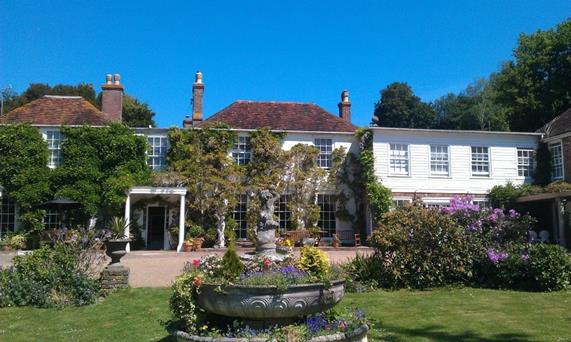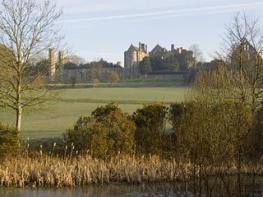The Laindons Guest House is a beautiful town house that occupies a quiet location only two…
Hastings Old Town and Hill

Follow cliff-side trails and travel by cliff railway on this spectacular coastal walk.
4 miles (6.4kms)
About the walk
Hastings has a real smack of the sea, with seagulls wheeling around fishing boats drawn up on the beach, known as the Stade, and a hugely characterful Old Town. Occupying a valley just to the east of the main part of town, this is a fascinating maze of tiny alleys, lanes and stepped paths with tiny cottage gardens and buildings spanning several centuries. Look out, for example, for the tiny Piece of Cheese House at 10 Starr Cottages (just off All Saints Street), named for its resemblance to a wedge of cheese, both in shape and colour.
The town is familiar to many as the backdrop of the TV series Foyle’s War. The western part of Hastings includes the predominantly Victorian resort town and the area of St Leonards, dominated by a huge apartment block erected in the 1930s. Known as Marine Court, it was designed to resemble an ocean liner. Hastings’ two town museums are both free to enter: one is on the High Street in the Old Town, while the other occupies a larger building in the newer part of town and contains the sumptuously ornate Durbar Hall, erected for the Indian and Colonial Exhibition in 1886. The Stade itself is home to Europe’s largest beach-launched fishing fleet, and makes for an enjoyable stroll, with its photogenic array of lobster pots, weather-beaten craft and fishing nets hanging out to dry. The net shops, which stand near the boats on the shingle beach, are not really shops at all but huts used for storing fishing nets and tackle. The huts, intentionally tall and narrow to reduce ground rent, are only found in Hastings. Two of them are often opened up for visitors to see; one of them, known as Half Sovereign Cottage, is formed of half a boat. Alongside them, the Jerwood Gallery houses a notable collection of modern British art in a sleek modern building clad with black ceramic tiles, designed to blend with the neighbouring net shops.
Hastings, most unusually, has the distinction of having two cliff railways. One ascends West Hill, reaching an expanse of lawn close to the ruins of Hastings Castle, part of which has crumbled over the cliff edge. On the East Hill is Britain’s steepest cliff railway; the journey is simple, short and straightforward and the views are magnificent. It takes you up to the start of the walk (note – it does not operate on weekdays in winter), above which are the only sandstone cliffs in southeast England; they have quite a different look to anywhere else in the region. Hastings is fortunate to have such dramatic scenery close by.
Walk directions
Turn left out of the car park, along Rock-a-Nore Road, to the East Hill cliff railway. Either take the ride to the top, or walk up. (If you prefer to walk, carry on along the road a few paces past the Dolphin Inn, then right up Tamarisk Steps, following the sign to East Hill half way up; at the top turn left on the road, then right up more steps to ascend to the upper cliff railway station.) Keep right up more steps, and follow the Fish Trail guideposts along the southern slopes of East Hill, with the sea on your right. Pass a beacon on your left and head steadily uphill.
Follow a diversion sign on which Ecclesbourne Glen and other places are mentioned. Pass the back entrance to Rocklands Holiday Park. Immediately afterwards turn right on an unmarked path that bears left. Keep going straight ahead, following landslip diversion signs. At a fingerpost turn right through a kissing gate with a diversion sign on it. Immediately fork left. At a guidepost on a junction of paths, ignore the kissing gate to your left and turn right. Continue descending across a path, over a boardwalk and a confluence of paths to climb steadily to pass a pond. Turn sharp right uphill at a guidepost 9 towards Fairlight Glen. Leave the woods shortly afterwards to climb a wide grassy path with pasture to your left. Cross a footbridge and head on past guidepost 10 to go through a kissing gate and into woods. Descend to a junction at guidepost 12 and turn left. Drop down some steps and ignore the path to the left.
At the bottom of Fairlight Glen, turn left at bollard 16 just before a stream signposted ‘Barley Lane’, up the glen. Ignore some steps leading down to the right and, just after, turn sharp left at a junction by bollard 15 (ahead here is a map). Follow the track out of the woods, keeping forward at some gates.
Reach Barley Lane and turn left along it. Carry on past a caravan park and Barley Lane car park.
Just after passing a path on the right signposted ‘Harold Road’ (which you ignore), fork left into Rocklands Lane (with a 15mph speed limit sign). Soon you will gain a view over the sprawling jumble of rooftops, with rows of terraced houses scattered over the slopes and hillsides. This is residential Hastings. Pass to the right of the entrance of Rocklands Holiday Park and keep on the upper track at the fork. Cross the grassy expanse of East Hill by aiming slightly right. Much of the town can be seen down below, creating an impressive picture. Keep to the right of the beacon passed earlier and reach the top of the East Hill cliff railway, either travelling on it to return or taking the steps just to the right to zig-zag to the bottom.
Additional information
Tracks, minor roads and coastal paths
High ground overlooking coast, with glens revealing layers of sandstone
Return section of walk, along coast path, is ideal for dogs off lead
OS Explorer 124 Hastings & Bexhill
Pay-and-display car park at Roc-a-Nore Road, Hastings
Near car park at start of walk
WALKING IN SAFETY
Read our tips to look after yourself and the environment when following this walk.
Find out more
Also in the area
About the area
Discover East Sussex
East Sussex, along with its western counterpart, is packed with interest. This is a land of stately homes and castles, miles of breezy chalk cliffs overlooking the English Channel, pretty rivers, picturesque villages and links to our glorious past. Mention Sussex to many people and images of the South Downs immediately spring to mind – ‘vast, smooth, shaven, serene,’ as the writer Virginia Woolf described them. She and her husband lived at Monk’s House in the village of Rodmell, near Lewes, and today, her modest home is managed by the National Trust and open to the public.
There are a great many historic landmarks within Sussex, but probably the most famous is the battlefield where William, Duke of Normandy defeated Harold and his Saxon army to become William the Conqueror of England. By visiting Battle, near Hastings, you can, with a little imagination, picture the bloody events that led to his defeat. East Sussex’s pretty towns such as Lewes, Rye and Uckfield have their charms, while the city of Brighton offers museums and fascinating landmarks, the best-known and grandest feature being the Royal Pavilion.
Nearby stays
Restaurants and Pubs
Nearby experiences
Recommended things to do
Why choose Rated Trips?
Your trusted guide to rated places across the UK
The best coverage
Discover more than 15,000 professionally rated places to stay, eat and visit from across the UK and Ireland.
Quality assured
Choose a place to stay safe in the knowledge that it has been expertly assessed by trained assessors.
Plan your next trip
Search by location or the type of place you're visiting to find your next ideal holiday experience.
Travel inspiration
Read our articles, city guides and recommended things to do for inspiration. We're here to help you explore the UK.
















